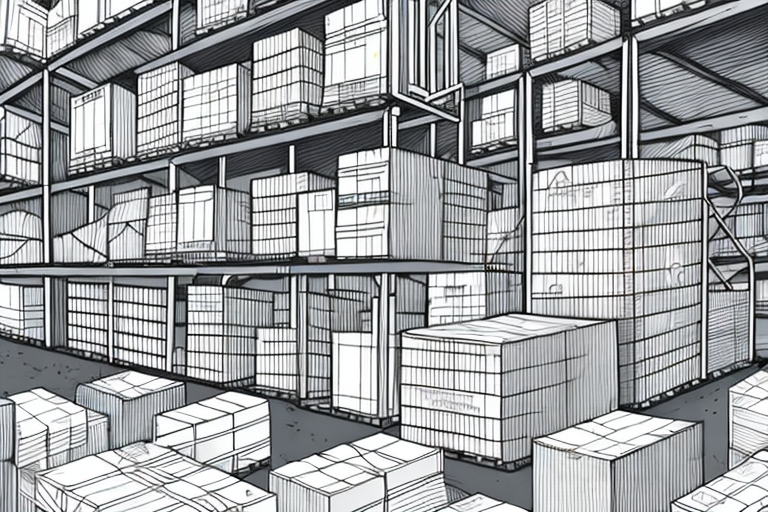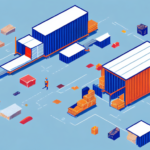The Importance of Reverse Logistics in E-commerce
Reverse logistics refers to the process of managing and disposing of goods that are returned to the seller by customers. In the e-commerce industry, returns are a common occurrence, with studies showing that return rates can range from 15-30% depending on the product category (Investopedia). Effective management of these returns is vital for retailers to ensure customer satisfaction, maintain profit margins, and minimize environmental impact. Given the vast scale of Amazon’s operations, the company’s reverse logistics strategies have a significant impact on its bottom line.
One of the key challenges in managing reverse logistics in e-commerce is the high cost associated with it. Retailers have to bear the cost of shipping the returned goods, inspecting them, and either restocking or disposing of them. According to a report by IBM, reverse logistics can account for up to 30% of a retailer’s operating costs. To mitigate these costs, some retailers have started offering incentives to customers for keeping the returned items, rather than shipping them back. This approach not only reduces the cost of reverse logistics but also encourages customers to make more purchases.
Another important aspect of reverse logistics in e-commerce is the environmental impact of returned goods. Many returned items end up in landfills, contributing to the growing problem of electronic waste. To address this issue, some retailers have started partnering with organizations that specialize in recycling and repurposing returned goods. By doing so, they not only reduce their environmental footprint but also create a positive brand image among customers who are increasingly conscious of sustainability.
Amazon’s Reverse Logistics Strategies
Understanding Amazon’s Supply Chain Management
One of the key factors behind Amazon’s success is its highly efficient supply chain management. The company’s supply chain encompasses multiple complex processes, including procurement, warehousing, inventory management, and transportation. By optimizing these processes, Amazon is able to offer fast and reliable delivery to customers at a lower cost than its competitors.
Amazon’s supply chain management also includes the use of advanced technologies such as robotics, artificial intelligence, and machine learning. These technologies are used to automate various processes, such as picking and packing in warehouses, and to analyze data to improve inventory management and forecasting (Forbes). Additionally, Amazon has implemented a system called “Frustration-Free Packaging” which reduces waste and makes it easier for customers to open and use their products.
Managing Returns and Excess Inventory
Amazon has a well-established process in place to manage returns and excess inventory. When a customer initiates a return, the product is first evaluated to determine whether it can be resold as new or needs to be refurbished or disposed of. If the product is in good condition, it is either restocked or sold as part of Amazon’s “Amazon Warehouse” program, which offers discounted products to customers. Amazon also uses predictive analytics to forecast the level of returns and adjust its inventory levels accordingly (Harvard Business Review).
In addition to these processes, Amazon also partners with third-party liquidators to sell excess inventory that cannot be resold through their own channels. These liquidators purchase the inventory in bulk and then sell it to other retailers or wholesalers. This allows Amazon to recoup some of the cost of the excess inventory and prevent it from taking up valuable warehouse space.
Integration of Sustainability in Amazon’s Reverse Logistics
The Role of Reverse Logistics in Sustainability Efforts
As a major player in the retail industry, Amazon has a responsibility to minimize its impact on the environment. The company has made significant strides in this area by implementing sustainability initiatives across various aspects of its operations, including reverse logistics. By refurbishing and reselling returned products, Amazon is able to reduce the amount of waste generated and promote a circular economy.
In addition to refurbishing and reselling returned products, Amazon also utilizes reverse logistics to optimize transportation and reduce emissions. By consolidating shipments and using more efficient routes, the company is able to minimize the carbon footprint of its logistics operations. According to Amazon’s Sustainability Report, the company aims to achieve net-zero carbon by 2040.
Furthermore, Amazon has implemented “Frustration-Free Packaging” which aims to reduce the amount of excess packaging materials used in shipping. This program not only reduces waste but also makes it easier for customers to open and use their products. By incorporating sustainable practices into its reverse logistics operations, Amazon is setting an example for other companies in the industry to follow and demonstrating its commitment to environmental responsibility.
Technological Innovations in Amazon’s Reverse Logistics
Advanced Technologies Enhancing Efficiency
Amazon has been at the forefront of adopting cutting-edge technologies to streamline its reverse logistics processes. The integration of robotics and automation in warehouses has significantly reduced the time and cost associated with processing returns. Additionally, Amazon leverages artificial intelligence and machine learning to analyze return data, predict return patterns, and optimize inventory levels (McKinsey).
Moreover, the implementation of blockchain technology is being explored to enhance transparency and traceability in the reverse logistics process. This ensures that every returned item is tracked accurately, reducing the chances of loss or mismanagement and improving overall operational efficiency.
Impact on Customer Satisfaction and Bottom Line
Enhancing Customer Experience
Customer satisfaction is a top priority for Amazon, and the company’s reverse logistics process is designed to ensure a smooth and hassle-free experience for customers. Amazon’s customer service representatives are trained to handle returns and address any complaints or issues that customers may have. Additionally, the company offers a range of return options to cater to different customer preferences, including drop-off locations, pick-up services, and mail returns (ZDNet).
Another key aspect of Amazon’s reverse logistics process is their use of technology. The company has developed sophisticated software that tracks returned items and analyzes the reasons for returns. This data is then used to improve product quality and reduce the number of returns in the future. Amazon also uses automation technology to streamline the returns process, reducing the time it takes for customers to receive refunds or replacements.
Furthermore, Amazon’s commitment to sustainability is reflected in their reverse logistics process. The company has implemented “Frustration-Free Packaging” which aims to reduce waste and improve the customer experience. This program involves using recyclable materials and designing packaging that is easy to open and dispose of. By reducing the amount of packaging waste generated by returns, Amazon is able to minimize their environmental impact while also improving customer satisfaction.
Financial Implications
Effective reverse logistics strategies have a significant impact on Amazon’s bottom line. By refurbishing and reselling returned products, the company is able to recover a portion of the cost and reduce the financial impact of returns. Additionally, proper management of excess inventory reduces the amount of money tied up in unsold products, allowing Amazon to invest in other areas of its business.
Another way that reverse logistics benefits Amazon is by improving customer satisfaction. By offering hassle-free returns and exchanges, customers are more likely to continue shopping with Amazon and recommend the company to others. This leads to increased sales and revenue for the company.
Furthermore, Amazon’s commitment to sustainability is also supported by its reverse logistics strategies. By refurbishing and reselling returned products, the company is reducing waste and extending the life cycle of products. This not only benefits the environment but also aligns with the values of many of Amazon’s customers, leading to increased loyalty and brand reputation.
Best Practices and Future Trends in Reverse Logistics
Best Practices for Online Retailers
Amazon’s success in reverse logistics can serve as a model for other businesses in the e-commerce industry. Some best practices include:
- Implementing a robust returns management system
- Using data analytics to forecast returns and inventory levels
- Offering a range of return options to cater to different customer preferences
- Partnering with recycling and repurposing organizations
- Leveraging technology to streamline the returns process
By adopting these strategies, businesses can reduce the financial impact of returns and enhance customer satisfaction.
Another important aspect of reverse logistics is the proper disposal or recycling of returned products. Businesses should have a clear policy in place for handling returned items that cannot be resold. This not only helps to reduce waste and environmental impact but also ensures compliance with regulations and laws related to product disposal (EPA).
In addition, businesses can also leverage reverse logistics as an opportunity to gather valuable feedback from customers. By analyzing the reasons for returns and customer feedback, businesses can identify areas for improvement in their products, services, and overall customer experience. This can lead to increased customer loyalty and retention, as well as improved brand reputation.
Future Trends in Reverse Logistics
The e-commerce industry is constantly evolving, and reverse logistics is no exception. With the rise of new technologies such as blockchain, artificial intelligence, and the Internet of Things (IoT), the reverse logistics landscape is set to transform rapidly in the coming years. Amazon is at the forefront of these innovations, and its continued investment in reverse logistics will likely set the standard for the industry as a whole (Forbes).
Challenges and Competitive Edge in Amazon's Reverse Logistics
Challenges in Managing Reverse Logistics
As with any complex system, managing reverse logistics comes with its own set of challenges. Some of the main challenges faced by Amazon in this area include:
- Managing the logistics of returns from third-party sellers
- Reducing the cost of refurbishment
- Effectively managing excess inventory
However, the company’s adoption of innovative technologies and emphasis on sustainability will likely help it overcome these challenges.
Competitive Advantage Over Competitors
Amazon’s reverse logistics strategies have set it apart from its competitors. By offering a seamless returns experience and using predictive analytics to manage inventory levels, Amazon is able to reduce the financial impact of returns and minimize waste. Additionally, the company’s focus on sustainability sets it apart from competitors who prioritize profit over environmental impact.
Amazon’s comprehensive approach to reverse logistics, which integrates advanced technology, sustainability, and customer-centric policies, provides the company with a competitive edge in the e-commerce market. This not only enhances operational efficiency but also strengthens customer loyalty and brand reputation.
Customer Insights and Case Study
Customer Insights: Expectations from a Good Return Experience
Customer expectations are important when it comes to managing returns effectively. Amazon’s customers expect a simple and hassle-free returns experience, with flexible return options and clear communication from the company. A study by Statista shows that 50% of online shoppers consider the ease of return processes a critical factor in their purchasing decisions. By prioritizing customer satisfaction in its reverse logistics strategies, Amazon has set a high bar for the industry as a whole.
Case Study: Amazon’s Comprehensive Reverse Logistics Strategy
Amazon’s success in reverse logistics can be seen through its implementation of a comprehensive strategy that encompasses multiple facets of the process. By using innovative technologies, promoting sustainability, and prioritizing customer satisfaction, Amazon has effectively managed its returns and excess inventory. This success has set the standard for the e-commerce industry as a whole.
Overall, Amazon’s reverse logistics strategies have played a crucial role in the company’s success in the e-commerce industry. By using innovative technologies, prioritizing sustainability, and emphasizing customer satisfaction, Amazon has effectively managed returns and excess inventory, reduced costs, and maintained its position as a leader in the industry. As the industry evolves, Amazon will continue to drive innovation and set the standard for reverse logistics strategies in e-commerce.





















